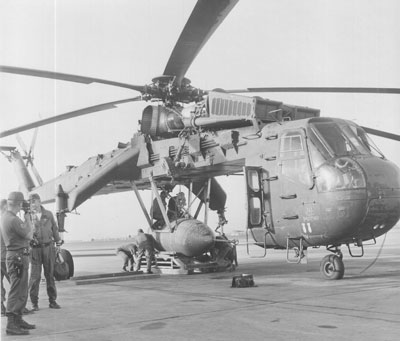
All hail the mighty Skycraneby Dwayne A. Day
|
| There is no explanation accompanying the artwork. It is possible that this was simply generic promotional artwork for the company rather than part of an internal Sikorsky study of a giant helicopter. |
Sikorsky Helicopters, in contrast, was a big helicopter company that built big helicopters. Igor Sikorsky is credited by most aviation historians as essentially inventing the helicopter. He did not come up with the idea, but he made it work. And by the early 1960s Sikorsky was building a lot of helicopters for the US military, particularly larger helicopters that could lift a lot of people and cargo. The Soviet Union built bigger helicopters, and Bell built a lot of smaller choppers, but Sikorsky built the military workhorses such as the SH-3 Sea King, which was used to recover the Apollo astronauts. Sikorsky also built the CH-54 Tarhe, also known as the Flying Crane or the Skycrane, still used in small numbers today by companies such as Erickson Air-Crane for hauling lumber and heavy cargoes, and firefighting. Sikorsky developed the Skycrane for commercial use and then pitched it to the Army, which bought a few dozen of the expensive helicopters and sent them to Vietnam, where they were pressed into service hauling howitzers and fuel and lifting downed helicopters out of rice paddies.
It turns out that Sikorsky at least entertained the idea of building an even larger “Super Skycrane.” Some promotional artwork from the 1960s depicts this beast hauling missiles for the US Air Force. In the artwork, one missile is shown slung underneath the helicopter while in the distance another missile is shown being erected underneath a second helicopter. It wasn’t nearly as ambitious as Hiller’s giant “Air Tug” for hauling the Saturn 5 first stage, but it was undoubtedly a lot more realistic.
There is no explanation accompanying the artwork. It is possible that this was simply generic promotional artwork for the company rather than part of an internal Sikorsky study of a giant helicopter. However, it may have also been tied to another more serious project within the US Air Force in the early 1960s, the mobile ballistic missile. Although there are few references to this in the public literature, in the early 1960s the Air Force undertook several studies of the possibility of building a mobile ICBM that could keep on the move so that the Soviet Union could not target it. These studies were underway at the same time that the Air Force was investing billions of dollars digging hundreds of giant gopher holes in the American Midwest in which it was planning to bury its Minuteman 1 and 2 ICBMs. Most of the concepts for this mobile ICBM involved putting it on railroad cars that would move through northern states, particularly New England, especially Maine.
Sikorsky’s Super Skycrane was never built. But the Skycrane that was built was pressed into service for hauling weapons around in Vietnam—and dropping them:
 Skycrane with 10,000 pound bomb. |